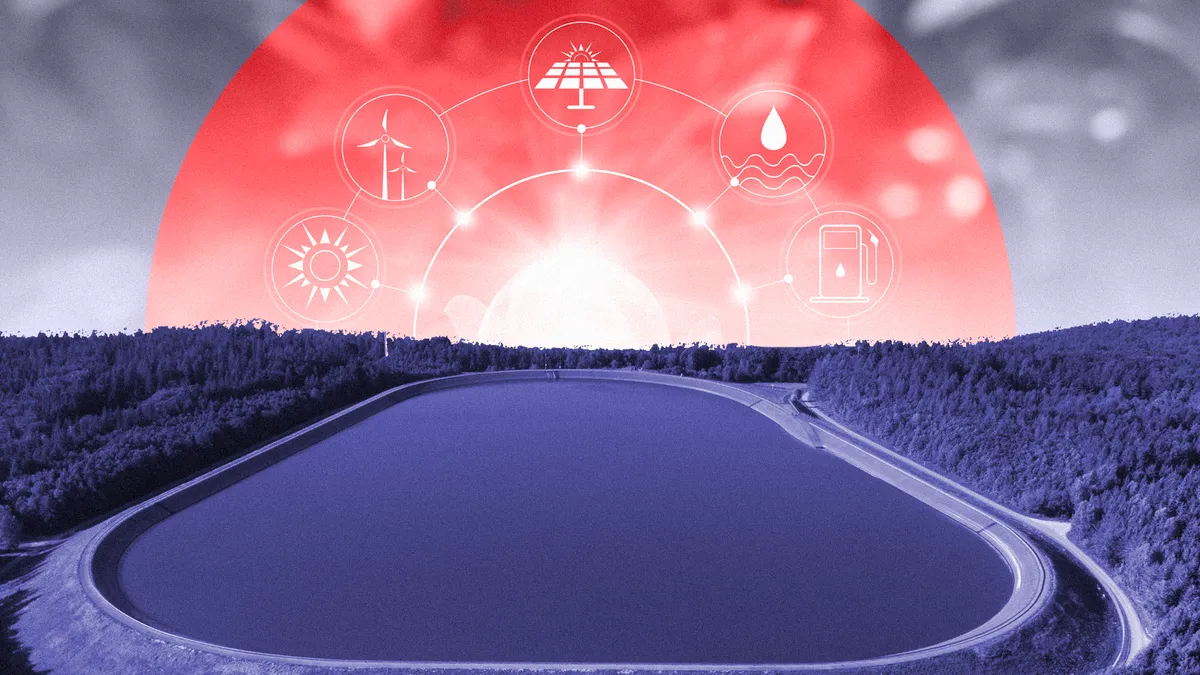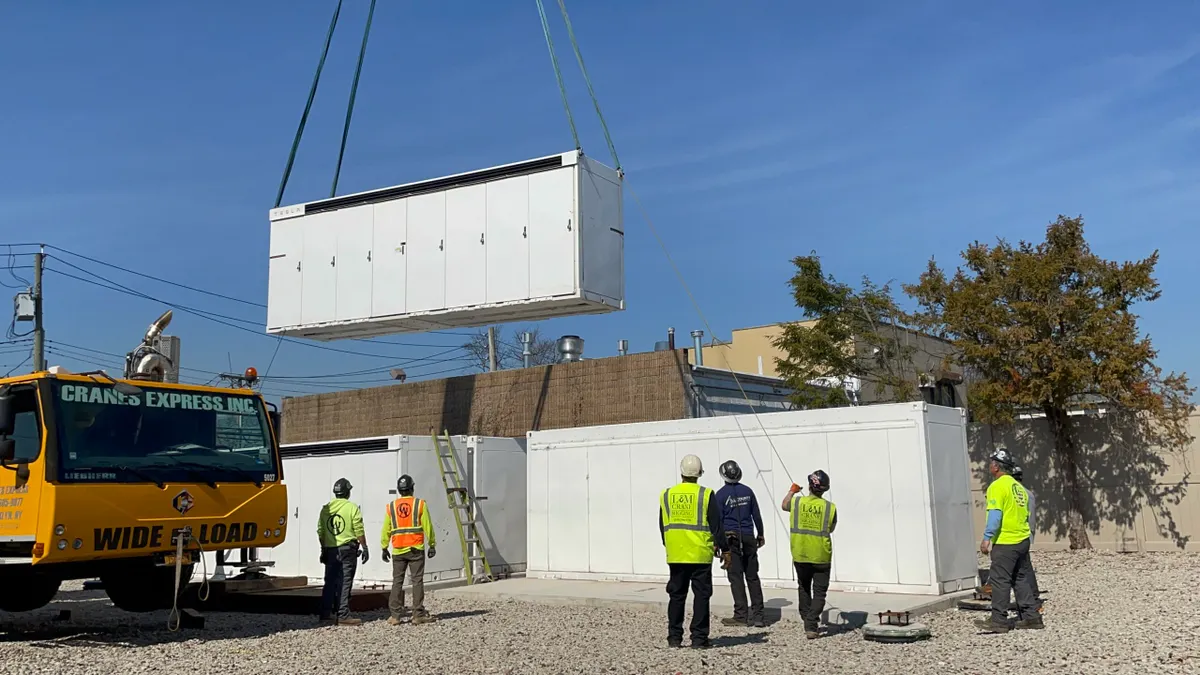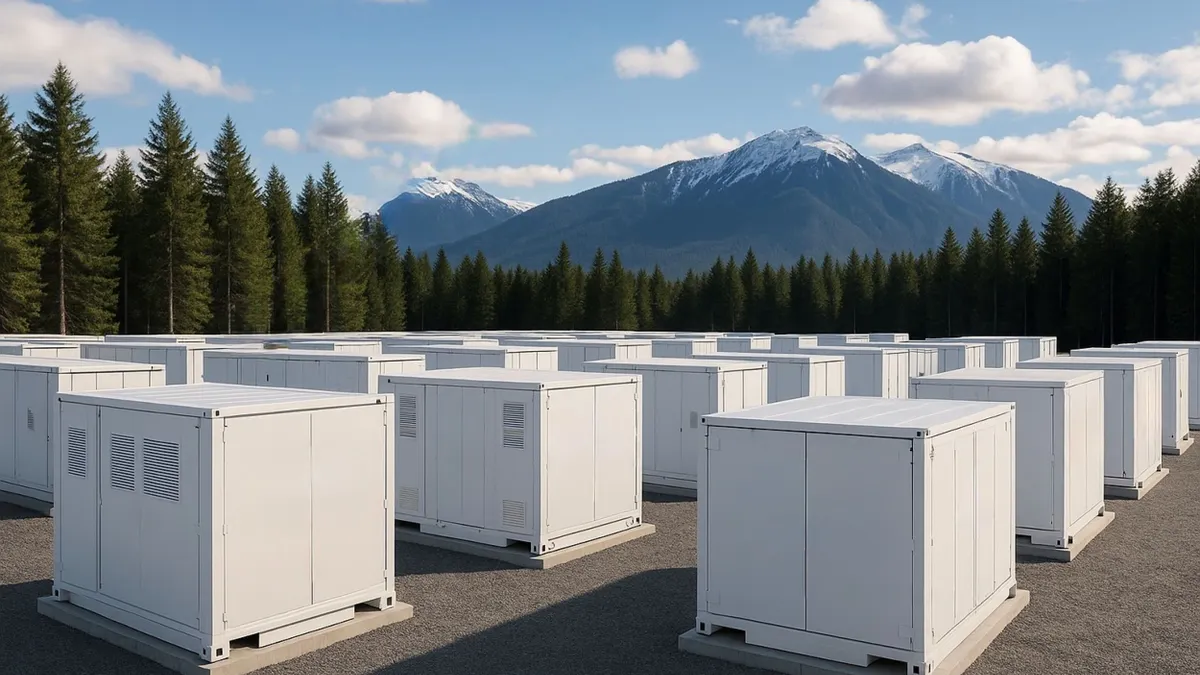At least 32 utilities are aiming to be carbon-free or achieve net-zero emissions by 2050. This is the second of a four-part series exploring the storage technologies that could get them there.
Around three or four years ago, Jim Day, CEO of Daybreak Power, came across a Bureau of Reclamation (BOR) study that listed dozens of locations around the country that could be viable for pumped hydro storage projects.
Day picked two — one close to the Hoover Dam in Arizona, and the other located in Navajo Nation territory, near Lake Powell, on the Utah-Arizona border — as potential candidates. In 2018, his company filed a preliminary permit application for the 1,540 MW Next Generation Pumped Storage project at the first location, and the following year, a second application for the 2,210 MW Navajo Energy Storage Station at the latter.
At the time of filing the applications, Day was new to project development. He previously worked at the U.S. embassy in Warsaw, wrapped up in climate negotiations and energy issues. However, he was convinced that moving towards carbon-free or carbon-neutral generation hinged entirely on building enough storage. And as he looked around at which technologies could provide massive quantities of storage in a cost-effective, proven way, he landed on pumped storage — a technology, he said, that could cycle deeply every single day, sucking up 10 hours’ worth of renewables and delivering that back to the grid day in and day out for decades.
"You just can’t keep bringing on more and more solar and wind, and just have it then stop when the sun goes down," Day said. "With pumped storage, they were all built some decades ago and they haven’t been built since then, because there was no demand for it…. But there is now, and there will be more and more and more in the coming years."
Pumped storage hydropower accounted for around 95% of commercial energy storage capacity in the U.S. as of 2018, with around 21.6 GW of installed capacity around the country. Facilities traditionally include two reservoirs, at different elevations; they draw power by pumping water to the upper reservoir, and generate it by passing that water through a turbine. But experts say it's notoriously difficult to find suitable locations for the pumped hydro plants, which are large, rely on specific geographies like mountains, and have prolonged permitting and development timelines that can stretch to a decade.
"Pumped storage is very difficult to site. It has a lot of environmental issues with it," said Glenn McGrath, leader of the electricity statistics, uranium statistics and product innovation team at the U.S. Energy Information Administration.
In 2017, the National Hydropower Association issued a white paper looking at the challenges and opportunities tied to developing new pumped storage, and noted that past projects have generally required constructing a minimum of one dam on main stem rivers, which could affect the local ecology. According to the report, developing "closed-loop" projects — built in areas not connected to river systems — could reduce those concerns.
"People license and permit and site and locate and finance and build big infrastructure projects all the time. To just write off pumped storage as if we can’t do that, to me, is silly."

Jim Day
CEO, Daybreak Power
In recent years, there appears to have been a renewed interest in the technology. In 2018, a U.S. Department of Energy analysis found that hydropower capacity in the U.S. could grow from 101 GW in 2015 to nearly 150 GW by the middle of the century, with 36 GW of new pumped storage capacity, based on a model that accounted for the growth in renewable generations, as well as the "inherent flexibility of pumped storage and its ability to provide needed operating reserves and other essential grid reliability services."
Some state regulators are also eyeing the possibility of pumped hydro. Earlier this year, the California Public Utilities Commission outlined the optimal portfolio to shepherd the state's electric sector to a 46 million metric ton target by 2030, which included an aggressive build out of renewables and storage, including approximately 1 GW of pumped storage, or a similar long-duration storage resource, by 2026.
"We all know the problems of getting new pumped storage in, there’s all sorts of challenges," Day acknowledged. "But I looked at it, and you know what? These are doable. People license and permit and site and locate and finance and build big infrastructure projects all the time. To just write off pumped storage as if we can’t do that, to me, is silly," he said.
'We know pumped storage works'
What will be required, according to Day, is putting in place structures that make pumped hydro storage economically and politically attractive. He’s currently got his eye on two or three other sites that he thinks also hold potential for projects, and his eventual goal is to have eight to 10 pumped storage sites in the pipeline in the next five years.
Day is developing the Next Generation and Navajo projects with an eye to markets in California, Arizona and Nevada. Both California and Nevada are aiming for carbon-free grids by 2045 and 2050, respectively. Arizona Public Service, the largest electricity provider in that state, also wants to deliver 100% carbon-free electricity by the middle of the century. These states are focusing on deploying battery storage projects at the moment, Day noted. But he’s betting that eight years from now or so, the need for larger volumes of storage at lower prices will be coming more into focus, driving demand for pumped hydro.
In the meantime, Day is navigating the lengthy permitting process around these projects — waiting for preliminary permits, potentially submitting a notice of intent to file a license application in around two years, meaning "we could realistically be getting the [Federal Energy Regulatory Commission] license in four or five years," he said. Simultaneously, the company will be going through the licensing process at the BOR. While the Navajo project will require both a FERC license and a BOR lease of power privilege, the Next Generation proposal falls solely in BOR’s jurisdiction.
One aspect that drew Day to both of the sites is their proximity to transmission resources — the Next Generation facility just requires a 12-mile transmission line to connect to a power hub that serves California and Southwestern states, while the Navajo project will use pre-existing power lines connected to the now shuttered coal-fired Navajo Generating Station. Pumped storage is an expensive proposition as it is, especially in terms of building the reservoirs and power houses and "once you start putting in longer transmission, the costs start going up a lot," he added.
But despite the steep costs, pumped storage still works from a cost standpoint because of its longevity, according to Day, with the ability to provide decades of storage. And while he hopes some of the more nascent technologies do evolve to the point where they can play a sizeable role on the grid, "we know pumped storage works," he said.
"I think it would be absolutely crazy to bet the farm on some totally unproven technology to provide the storage that is key to integrating renewables, cutting out greenhouse gas emissions and avoiding the climate change disaster," Day added.
Think pumped storage — but more flexible
Pumped storage is not going anywhere, Daniel Finn-Foley, head of energy storage at Wood Mackenzie, agreed. It’s a critical grid tool that’s being used right now, Finn-Foley said, and if there is an opportunity to build more pumped storage, it’s absolutely going to happen, given that it’s a well-understood, effective technology that can store large amounts of energy.
"[T]he big question is, is there going to be some sort of pumped hydro that sidesteps those geographical, locational concerns?"

Daniel Finn-Foley
Head of Energy Storage, Wood Mackenzie
But to a certain extent, all the good places to site a pumped hydro project in the U.S. have been utilized, according to Finn-Foley. Looking out to the next two decades, the grid is going to be viewed as something of a real estate deal — everything will center around location. But unlike smaller, decentralized storage systems, which can be sited to meet specific locational needs at the substation level, a centralized asset like pumped hydro, which can only be put in certain spots, may fall behind in 20 years, when location becomes king.
"People are going to continue to keep looking… but the big question is, is there going to be some sort of pumped hydro that sidesteps those geographical, locational concerns?" Finn-Foley said.
One company that’s working on such a solution is Quidnet Energy, which has developed a geomechanical pumped storage technology that uses subsurface rock layers, eliminating many of the geographic restrictions that come with traditional pumped storage.
The process essentially involves a pond, a well that can be open or closed, and a rock formation. Surplus electricity is used to pump water from the pond, through the well and into the rock, where it remains in pressurized form. When there’s a need for electricity, the water is channelled over a turbine to create power. The process is closed loop — after passing through the turbine, the water is routed back into the first pond — and can be deployed at a 1 MW to 10 MW range, according to the company, rather than the hundreds of MWs or even GWs associated with pumped storage.
The end result is a system that’s a lot more flexible than traditional pumped storage, Joe Zhou, CEO of Quidnet, said.
"You don’t need mountains — there’s no pumped hydro in Texas, for example, for that reason," and that reduces construction costs significantly, Zhou said. And because the process doesn’t involve the environmental permitting protocols that pumped storage does, the company is working with months of lead time rather than five or 10 years.
In June, Quidnet announced that it had been contracted by the New York State Energy Research and Development Authority (NYSERDA) to deploy a 2 MW project in the state, as a demonstration of its technology. The facility will have a 10-hour duration, the company said at the time, with per-kilowatt installed costs that will be less than half of traditional pumped storage.
NYSERDA was drawn to the technology for multiple reasons, according to John Lochner, vice president of innovation at NYSERDA, including its potential to provide low-cost, long-duration storage that makes use of local and domestic supply chains, and employs the local workforce. In addition, "we saw an opportunity with the modular and scalable nature of the technology."
Pumped hydro currently plays an important role in balancing the grid, Lochner said, and he expects to see it provide an increasingly valuable part as the system shifts to more intermittent sources of power. But a 100% clean grid will need storage resources with a variety of durations and use cases both behind and in front of the meter, Lochner added, and new pumped storage approaches — along with the traditional technology — could offer potential as low-cost solutions.
Financing and market challenges remain
But pumped hydro deployments face challenges beyond just location — for instance, finding investors who are willing to contribute funds upfront. Day’s method for dealing with this is finding investors who can put in smaller amounts of money to conduct the initial studies for the facilities, and then work on derisking them as much as possible, before scaling up to the funds required to figure out front-end engineering, navigating the FERC and BOR licensing processes, and so on.
"I think the industry as a whole has work to do in realizing the value of storage, or having markets recognizing the value of storage."

Joe Zhou
CEO, Quidnet
Getting the FERC license will be a big milestone for the projects, Day said, at which point the company hopes to be in advanced discussions with potential offtakers, or future owners and operators of the plant.
"We’re trying to sort of do all these things concurrently," he said.
Quidnet’s Zhou sees two key challenges for the technology and company — the way storage is treated from a market perspective, and making sure that the company is keeping in close contact with the project finance community as they scale up.
"I think the industry as a whole has work to do in realizing the value of storage, or having markets recognizing the value of storage," Zhou said.
Looking out to the end of the decade, and the accompanying carbon reduction goals or states and utilities, "I think we already have a big toolbox — much bigger than most people give credit for — of things that we know can work in certain ways," Day said, including pumped hydro, lithium-ion batteries, even demand response efforts.
Day expects that the highly renewable grid of the future will be supported by a combination of these storage resources, as well as, possibly, emerging technologies like hydrogen.
"So get in some 10, 20, or 30 big pumped storage facilities — that’ll be the big guns, the heavy artillery — and then a lot of distributed [storage] or standalone batteries in specific sites that’ll fill in a lot of the blanks."























